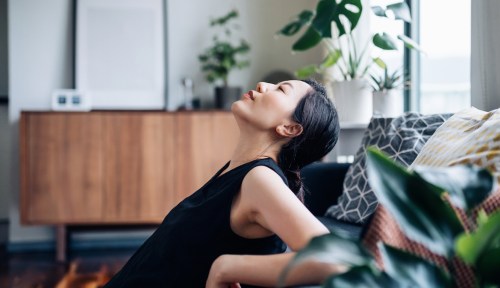Our editors independently select these products. Making a purchase through our links may earn Well+Good a commission
‘I’m a Meditation Practitioner of 10 Years, and These Are the 6 Grounding Techniques That I Personally Use’
Here's how Susan Chen incorporates grounding techniques into her day to stay calm when things get stressful.

In her previous life working in finance, Susan Chen, founder of Susan Chen Vedic Meditation, was no stranger to feeling the constant thrum of activity and excitement that quickly leads to overwhelm. Since taking up a meditation practice 10 years ago to temper her stress, she’s developed a full arsenal of grounding techniques that she turns to daily.
Experts in This Article
meditation expert and founder of Susan Chen Vedic Meditation
“After learning to meditate, I felt a lightness and joy return to my day-to-day that I hadn’t felt in years,” she says. Her desire to learn more about meditation resulted in her taking a one-year sabbatical in 2016 during which she studied in India before opening her own practice in 2017. She focused her learning on Vedic meditation, which is rooted in the Vedas, the ancient Indian tradition that’s also the basis for yoga and Ayurveda. For this reason, many of Chen’s favorite grounding techniques are traditional Ayurvedic practices.
Below, Chen shares more on why it’s important to have grounding techniques you can turn to and reveals the six that she uses to stay grounded herself.
Why grounding techniques are helpful
To understand why feeling grounded is important, just consider what it’s like to feel ungrounded. Think about when you just feel like your attention is being pulled in a million directions, and like you can’t focus. “It’s feeling unsettled in your body and mind,” Chen says.
To be sure, it’s totally normal to feel excited or revved up in response to the things going on in your day-to-day life, but if you start to feel unmoored often or even most of the time, it gets tough to come back down. Grounding practices are a means of infusing some calm into your life. “Any practice of grounding will take the mind and body from a state of what we would call disorderliness or disarray, or the most excited state, and begin to bring the body into a more calm state,” Chen explains.
“Any practice of grounding will take the mind and body from a state of what we would call disorderliness or disarray, or the most excited state, and begin to bring the body into a more calm state.” —Susan Chen, meditation expert
There are numerous grounding techniques, and you can do whichever ones interest and suit you best. Meditation, yoga, and breathwork for grounding are all ways to create calm and peace within the chaos. Specific patterns, like the five senses grounding ritual or 54321 grounding technique, are another way you could anchor yourself. Even lying on the floor is an option. The key, Chen says, is to find whatever works best for you.
6 grounding techniques that meditation expert Susan Chen uses daily
1. Daily Vedic meditation
The core tenet of Chen’s grounding practice is her daily meditation practice. Vedic meditation, which is based on the ancient Veda texts, involves a twice-daily mantra-led meditation. Chen starts her morning with a 20-minute meditation, and then does one later in the day, too. “[Vedic meditation] is a way of systematically taking the mind and body into the deepest level of stillness that one can experience outside of sleep, and that experience of deep calm and restfulness has a carryover effect in all of those other hours of the day that you’re not meditating,” she says. “It just gives us that extra buffer of rest and nourishment because our stress doesn’t take a day off.”
2. Sticking to a daily routine
Sticking to her established routine most of the time is another way Chen grounds herself. The health benefits of routines are well established; routines can help set you up for success by ensuring you do all you need to do to get proper sleep and movement, plus manage stress. Chen says establishing and sticking to a routine is a tenet of Ayurveda, as well. “A normal and regular routine is one of the best ways to ‘ground’ from a preventative perspective,” she says.
3. Sipping warm liquids
Warm drinks like water and tea are always within Chen’s arm’s reach, and she sips on them throughout the day. The warm liquid has a calming and soothing effect. Consuming warm liquids is an Ayurvedic practice, but Chen says we can look to our own lives for why this works, too. “There’s this wise wisdom that comes from our mothers and grandmothers where we know eating warm, comforting foods is really good for grounding,” she says.
4. Giving herself warm oil massages
Chen’s mornings start with Abhyangha, or a warm oil massage. The Ayurvedic practice refers to covering the body with oils and is associated with reduced stress and calm. As Rooshy Roy, co-founder and CEO of Ayurvedic skin-care brand Aavrani previously told Well+Good, “In Ayurveda, health comes from a balanced state, and the release from this massage helps to reset energy and return the body to an optimally balanced state.” This is exactly why Chen prioritizes this each morning, she says.
Using long strokes to rub the warm oil all over her body, Chen leaves it on for eight minutes before washing it off in the shower. “It feels like it gives my nervous system an additional layer of armor and resiliency for the day and it’s like a big warm hug for your whole body,” she says. In the spring and summer she uses coconut oil, and sesame oil in the colder seasons.
5. Performing sun salutations
Sun salutations, or surya namaskar, are another key piece in Chen’s toolbox of grounding techniques, and one she peppers throughout her day. Meaning to bow to the sun in Sanskrit, the sequence of yoga poses is rooted in ancient traditions. The calming and stress-relieving effects, combined with gentle physical movements, make the foundational yoga move one of Chen’s preferred methods to ground herself. “It’s a great way to connect the mind and body, and it can be done at any time of the day,” she says.
She does several sun salutations each morning, but will also do one at any point in the day if she feels it’s necessary as a pattern interrupt or an action that signals to her mind it’s time to transition activities.
The below routine offers a grounding series of sun salutations:
6. Earthing
Imagine the calm feeling that rushes over you when you stand or lie barefoot in the grass—if you’re familiar, you may have tried earthing, another of Chen’s favorite grounding techniques. Earthing, which has its roots in several cultural traditions, is exactly what it sounds like—physically touching the earth and reaping the benefits of your body’s connection to it. Whether done standing barefoot or lying down, earthing is about allowing your body’s ions to connect with those on the earth to produce a feeling of calm.
Earthing has been associated with reduced stress and inflammation. Chen uses this as a pattern interrupt when she’s feeling particularly ungrounded. “The connection of the soles of your feet to the ground is literally grounding, and cultivating the connection gets us in the present moment,” she says. “It’s like, ‘let me just ground myself onto the earth and start to feel a little bit of relaxation from that.’”
Sign Up for Our Daily Newsletter
Get all the latest in wellness, trends, food, fitness, beauty, and more delivered right to your inbox.
Got it, you've been added to our email list.










